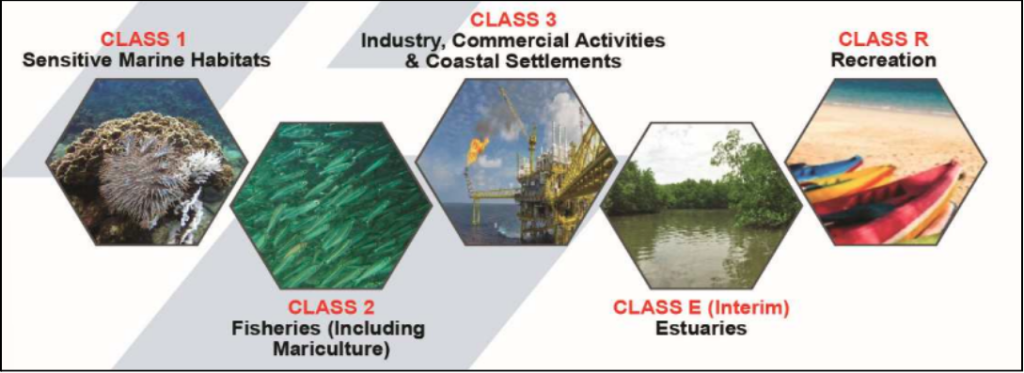Reducing Marine Pollution
Universiti Kebangsaan Malaysia (UKM) is dedicated to safeguarding marine ecosystems by adhering to the Malaysian Marine Water Quality Standards and Index, aligning with SDG 14: Life Below Water. Through rigorous research, pollution control, and sustainable practices, UKM actively reduces marine pollution from campus activities. By conducting regular water quality assessments and promoting responsible waste management, UKM protects aquatic environments, supporting resilience and biodiversity in marine and coastal ecosystems. This commitment not only advances marine conservation but also sets a standard for environmental stewardship in higher education.
UKM Sustainability Strategic Plan 2030
UKM aims to create a comprehensive policy on the conservation of marine ecosystems and biodiversity as part of its commitment to sustainability under SDG 14. This policy will focus on preserving marine biodiversity within UKM’s natural laboratories and surrounding environments. Key initiatives include developing specific guidelines and strategies for protecting marine habitats and promoting biodiversity. This policy framework will guide UKM’s actions in conserving marine life, maintaining ecological balance, and fostering sustainable practices in marine resource management. The target is to establish clear policy guidelines on marine ecosystem conservation that align with UKM’s role as a sustainable campus and leader in environmental stewardship, with oversight from the Head of SDG 14 to ensure effective implementation and alignment with global marine conservation goals (page 44).

https://www.ukm.my/kelestarian/data/publications/UKM-SUSTAINABILITY-STRATEGIC-PLAN-2030.pdf
Malaysian Marine Water Quality Standards and Index
UKM adheres to the Malaysian Marine Water Quality Standards and Index published by the Ministry of Energy, Science, Technology, Environment & Climate Change to effectively reduce marine pollution through comprehensive research, monitoring, and sustainable practices. By implementing these standards, UKM focuses on controlling pollutant levels in campus-related water bodies, ensuring that discharges meet acceptable levels for heavy metals, nutrients, and organic contaminants. Regular water quality assessments, pollution control measures, and responsible waste management on campus align with these national guidelines, helping to protect aquatic ecosystems from harmful pollution. UKM approach also includes community awareness campaigns, partnerships with environmental agencies, and innovative research projects that explore sustainable alternatives to harmful materials. By following the Malaysian Marine Water Quality Standards and Index, UKM not only promotes marine conservation but also sets an example for responsible environmental stewardship, supporting the health and resilience of marine and coastal ecosystems.
The Malaysian Marine Water Quality Standards and Index booklet outlines standards and indices for evaluating marine water quality in Malaysia. It provides guidelines for assessing pollution levels and categorizes water quality into various classes based on pollutant concentrations and ecological impact. This document is instrumental for policymakers, environmental agencies, and industries, as it defines acceptable contaminant levels including heavy metals, nutrients, and organic pollutants to protect marine ecosystem health.
Key components include:
- Water Quality Parameters: The standards specify permissible concentrations for various pollutants, such as heavy metals (like mercury and cadmium), nutrients (such as nitrates and phosphates), oil and grease, and microbiological contaminants, aiding in assessing water quality and identifying pollution sources.
- Classification of Marine Water: Water quality is classified into different classes (e.g., Class 1, Class 2) according to its suitability for uses such as conservation, recreational activities, and industrial purposes. Each class has specific criteria to guide water management and pollution control measures.

- Malaysian Marine Water Quality Standards (MMWQS): This standard summarizes water quality data by combining various parameters into a single value, facilitating the communication of overall water quality and helping to identify areas requiring intervention.
These strategies collectively aim to foster a more sustainable agrofood sector in Malaysia, addressing the increasing food demand while safeguarding environmental integrity (Page 22).

- Pollution Control and Management: The standards serve as benchmarks for pollution control, guiding regulatory measures for industries and coastal developments to prevent harmful contaminant levels that could endanger biodiversity and human health.
- Monitoring and Compliance: The booklet underscores the importance of regular monitoring and reporting. Government agencies, industries, and research institutions are encouraged to adhere to these standards to protect Malaysia’s marine resources.
Overall, the Malaysian Marine Water Quality Standards and Index is vital for preserving marine ecosystems by establishing a framework for pollution management, setting clear quality objectives, and promoting sustainable practices in marine and coastal areas.
Policy Created: 2010
Policy Reviewed: 2030
- Community Awareness
World Clean Up Day 2023
UKM participation in World Clean Up Day 2023, led by the Pusat Penyelidikan Langkawi (PPL-ALAF), is an actionable commitment to SDG 14: Life Below Water, targeting plastic waste reduction and ecosystem protection. A dedicated group of 40 UKM delegates collaborated with LADA (Langkawi Development Authority), E-Idaman, and the local community to clean up an island near Pulau Pasir Panjang, addressing plastic and other pollutants that pose severe threats to marine biodiversity. This hands-on conservation effort included a visit to the Geopark Discovery Centre, followed by an immersive cleanup activity, aiming to directly reduce pollution in this sensitive area while fostering a collective understanding of the environmental impacts of plastic waste. This initiative is part of UKM broader action plan to reduce plastic waste and protect aquatic life by promoting responsible waste management practices, both on campus and in surrounding communities. The event also served as an educational platform, reinforcing the importance of community-driven environmental stewardship and supporting long-term resilience in Malaysia’s ecosystems. Through partnerships and proactive participation in local conservation efforts, UKM not only champions SDG 14 but also inspires sustainable practices that protect both marine and terrestrial ecosystems for future generations.

